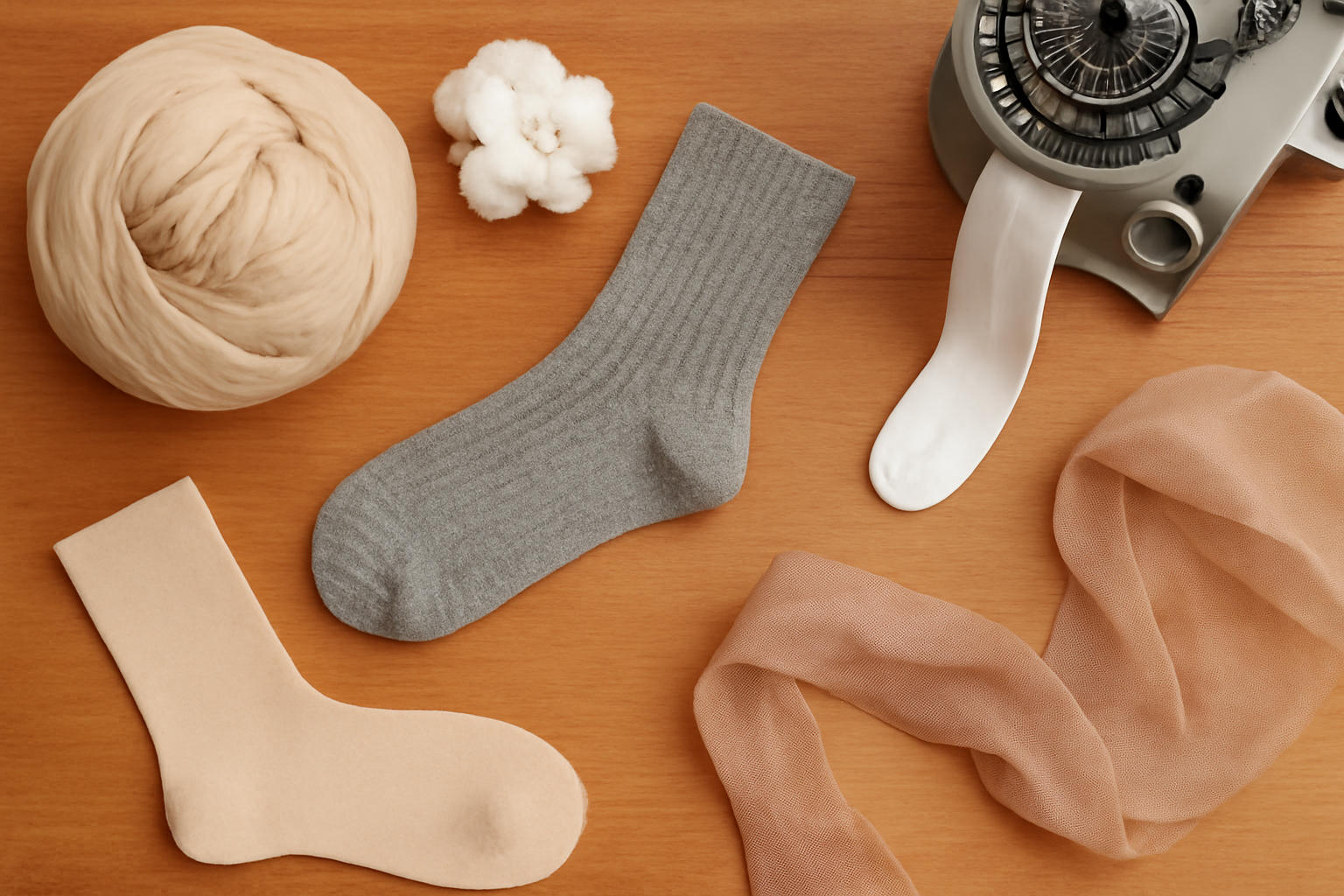
Hosiery Production Materials: The Essential Fabrics for Quality Socks
July 22, 2025
When it comes to hosiery production, the choice of fabric plays a pivotal role in determining the comfort, durability, and overall quality of the final product. Hosiery products, especially socks, come in various types and styles, each requiring specific materials that not only enhance performance but also ensure longevity. Let’s explore the different fabric types used in hosiery production, focusing on the best and most durable materials for socks.
Fabric Types Used in Hosiery Production
The world of hosiery production offers a wide range of fabric options, each with its unique properties. The most common fabric types used in the production of socks include cotton, wool, nylon, polyester, and blends of these materials. Each fabric serves a different purpose, catering to the specific needs of comfort, flexibility, and style.
- Cotton: Known for its softness and breathability, cotton is a popular choice for casual and everyday socks. It is hypoallergenic, making it ideal for sensitive skin, and absorbs moisture, helping keep feet dry throughout the day. However, cotton socks may not be as durable as other synthetic fabrics, especially under heavy use.
- Wool: Wool is an excellent fabric for socks meant for colder climates. It provides insulation and warmth, even when wet. Merino wool, a finer type of wool, is often used for socks to enhance softness and reduce itching, making it ideal for both casual wear and outdoor activities.
- Nylon: Nylon is often blended with other fabrics to add strength and elasticity to socks. It is lightweight, durable, and resistant to wear and tear. Nylon helps socks retain their shape and improves their stretchability, making them perfect for a snug fit.
- Polyester: Polyester is a synthetic fiber known for its moisture-wicking properties. It keeps feet dry by drawing moisture away from the skin and allowing it to evaporate. Polyester socks are durable and resistant to shrinking, but they may not be as breathable as natural fabrics like cotton and wool.
- Blends: Many socks are made from a combination of these materials to balance the benefits of each fabric. For example, cotton-nylon blends offer the softness of cotton and the durability of nylon, making them ideal for both comfort and longevity.
Best Fabric Types for Socks: Which One Should You Choose?
When choosing the best fabric for socks, several factors come into play. It all depends on the intended use, the climate, and the desired features such as breathability, moisture-wicking, and warmth.
- For Comfort: Cotton is often the best choice for those seeking comfort and softness. Cotton socks are ideal for daily wear and are especially good for warmer months. They allow feet to breathe, reducing the risk of irritation or odor.
- For Cold Weather: Wool is the top choice for socks designed for colder conditions. Its insulating properties keep feet warm, and its moisture-wicking ability ensures that feet stay dry, even in snowy or wet conditions. Merino wool is particularly known for its fine texture and is less itchy compared to traditional wool.
- For Performance: If you need socks for athletic purposes or long hikes, blends of synthetic fibers like nylon and polyester may be your best bet. These materials help wick away sweat, keeping feet dry and reducing the risk of blisters. They also offer greater durability and elasticity, ensuring that the socks maintain their shape and fit over time.
Most Durable Fabric Types for Socks
Durability is key when it comes to hosiery production, especially for socks that are intended for heavy-duty use. Fabrics like nylon, polyester, and certain wool blends are known for their resilience and ability to withstand wear and tear.
- Nylon: Among the most durable fabrics, nylon is often used in performance socks due to its strength and stretch. It resists abrasions, ensuring that socks last longer even with frequent use. Additionally, nylon is resistant to damage from exposure to sunlight and chemicals, making it a reliable choice for socks meant for active wear.
- Polyester: Polyester is also highly durable and resistant to shrinkage and fading. It is less likely to lose its shape after multiple washes and retains its vibrant colors for longer periods. Socks made from polyester are particularly good for long-lasting wear and high-performance activities.
- Blended Fabrics: The combination of natural fibers like cotton with synthetic fibers like nylon and polyester often results in socks that offer the best of both worlds—comfort and durability. These blends are ideal for people who need socks that feel good and perform well under stress.
In hosiery production, the choice of fabric is critical to ensuring that the final product meets both functional and aesthetic needs. By selecting the right fabric, you can create socks that are not only comfortable and stylish but also durable enough to withstand daily wear. Whether you choose natural fibers like cotton and wool or synthetic materials like nylon and polyester, the key is finding the right balance for your specific needs.
For businesses involved in hosiery production, understanding fabric properties and their impact on performance is essential for creating high-quality products that meet consumer expectations. By selecting the best materials, you can ensure that your socks provide lasting comfort, durability, and style.
Welcome to the Wonderful World of Penti!
Thanks to our 70 years of experience; as of right now we are Europe’s Largest Fully Integrated Hosiery Manufacturer with a very strong focus on both digitalization and sustainability.
Please share your contact information with us for your hosiery demands both in Private Label and Penti Branded products for wholesale.
